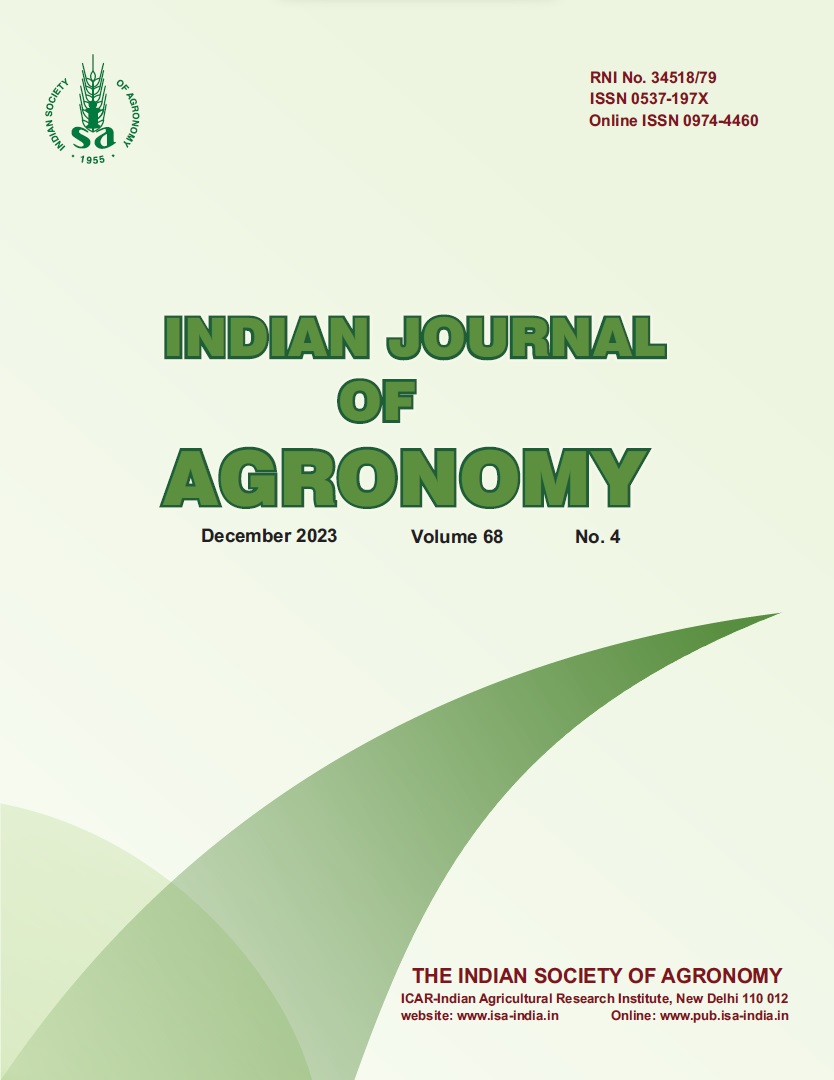Efficacy of pyroxasulfone and its combinations against weeds in wheat (Triticum aestivum)
DOI:
https://doi.org/10.59797/ija.v68i4.5470Keywords:
Hand weeding, Herbicidal applications, Pre-emergence herbicides, Pyroxasulfone + metribuzin, Weed flora, WheatAbstract
A field experiment was conducted during the winter (rabi) season of 2021–22 at the research farm of Jawaharlal Nehru Krishi Vishwa Vidyalaya, Jabalpur, Madhya Pradesh to study the efficacy of pre-emergence herbicides against weeds in wheat (Triticum aestivum L.). The experiment was laid out in a randomized block design with 3 replications and 8 weed control treatments. Major weed flora in the experimental site, viz. Medicago polymorpha (L.) (28.97%) and Cichorium intybus (L.) (26.19%) were predominant in dicot weeds and in monocot weeds, Phalaris minor (17.82%) was dominant. The weedy check plot had the higher density and dry weight of weeds. Hand weeding (once) was done at 25 DAS (day after sowing) in wheat, reducing weeds density and dry weight to the maximum extent at 40 DAS with a weed control efficiency (WCE) of 92.8%, proving superiority over other treatments. Among the herbicidal applications, pyroxasulfone + metribuzin at 127.5 + 280 g a.i./ha significantly reduced the monocot and dicot weeds density and dry weight, followed by pendimethalin + pyroxasulfone at 1250 + 127.5 g a.i./ha. Pyroxasulfone + metribuzin at 127.5 + 280 g a.i./ha resulted in maximum values of growth parameters, viz. plant height (66.38 cm), number of tillers/m2 (403.14) and yield attributing characters, viz. grains per earhead (51.00) and grain yield (5.65 t/ha) as compared to other herbicidal treatments.References
Anonymous. 2021. Annual Report 2021–2022, Department of Agriculture and Cooperation, Ministry of Agriculture, Government of Madhya Pradesh.
Jha, A.K., Kewat, M.L., Upadhyay, V.B. and Vishwakarma, S.K. 2011. Effect of tillage and sowing management on productivity, economics and energetics of rice-wheat cropping system for Kamore Plateau and Satpura hill zone of Madhya Pradesh. Indian Journal of Agronomy 56(1): 35–50.
Kumar, R., Singh, R.S., Jaidev and Kumar, M. 2017. Effect of herbicides on weeds, grain yield and soil health in wheat. Indian Journal of Weed Science 49(1): 88–89.
Lakra, K., Pyare, Ram, Singh, Puneet Kumar, Verma, Sunil Kumar, Singh, Rajiv Kumar, Upadhyay, Kumar, Pravin and Tyagi, Vishal. 2022. Effect of irrigation schedule and herbicides application on growth and productivity of wheat (Triticum aestivum) in semi-arid environment. Indian Journal of Agronomy 67(2): 129–136.
Meena, V., Kaushik, M.K., Dotaniya, M.L., Meena, B.P. and Das, H. 2019. Bio-efficacy of readi-mix Science 51(4): 344–351.
Raghav, P., Jha, A.K., Badal, V., Rahul, K. and Richa, S. 2023. Bio-efficacy of pinoxaden as post-emergence herbicide against weeds in wheat crop. Pollution research 42(1): 115–117.
Punia, S.S. Soni, J., Singh, S.K. and Kamboj, P. 2020. Management of herbicide resistant Phalaris minor in wheat. Indian Journal of Weed Science 52(3): 237–240.
Sangwan, M., Hooda, V., Singh, J. and Duhan, A. 2019. Herbicidal weed management in dual purpose tall wheat. Indian Journal of Agricultural Sciences 89: 141–144.
Rani, Sarita, Kumar, Suresh, Hooda, V.S. and Kumar, Satish. 2021. Bio-efficacy of metribuzin based herbicide mixtures on weeds and productivity of wheat. Indian Journal of Agronomy 66(4): 407–412.
Singh, R.S., Kumar, R., Kumar, M. and Pandey, D. 2019. Effect of herbicides to control weeds in wheat. Indian Journal of Weed Science 51(1): 75–77.
Tanisha, Nirala, Jha A.K., Badal Verma, Pushpendra Singh Yadav, Mahendra Anjna and Lakhan Bhalse. 2022. Bio efficacy of pinoxaden on weed flora and yield of wheat (Triticum aestivum L.). Biological Forum–An International Journal 14(4): 558–561.
Tomar, D.S., Jha, A.K., Verma, B., Meshram, R.K., Porwal, M., Chouhan, M. and Rajpoot, A. 2023. Comparative efficacy of different herbicidal combinations on weed growth and yield attributes of wheat. International Journal of Environment and Climate Change 13(8): 889–898.
USDA. 2021. World Agricultural Production, United States, Department of Agriculture, Foreign Agricultural Service, Circular Series. WAP 2–21. February 2021.






